Media And Crime In Australia
VerifiedAdded on 2022/08/17
|9
|2350
|12
AI Summary
Contribute Materials
Your contribution can guide someone’s learning journey. Share your
documents today.
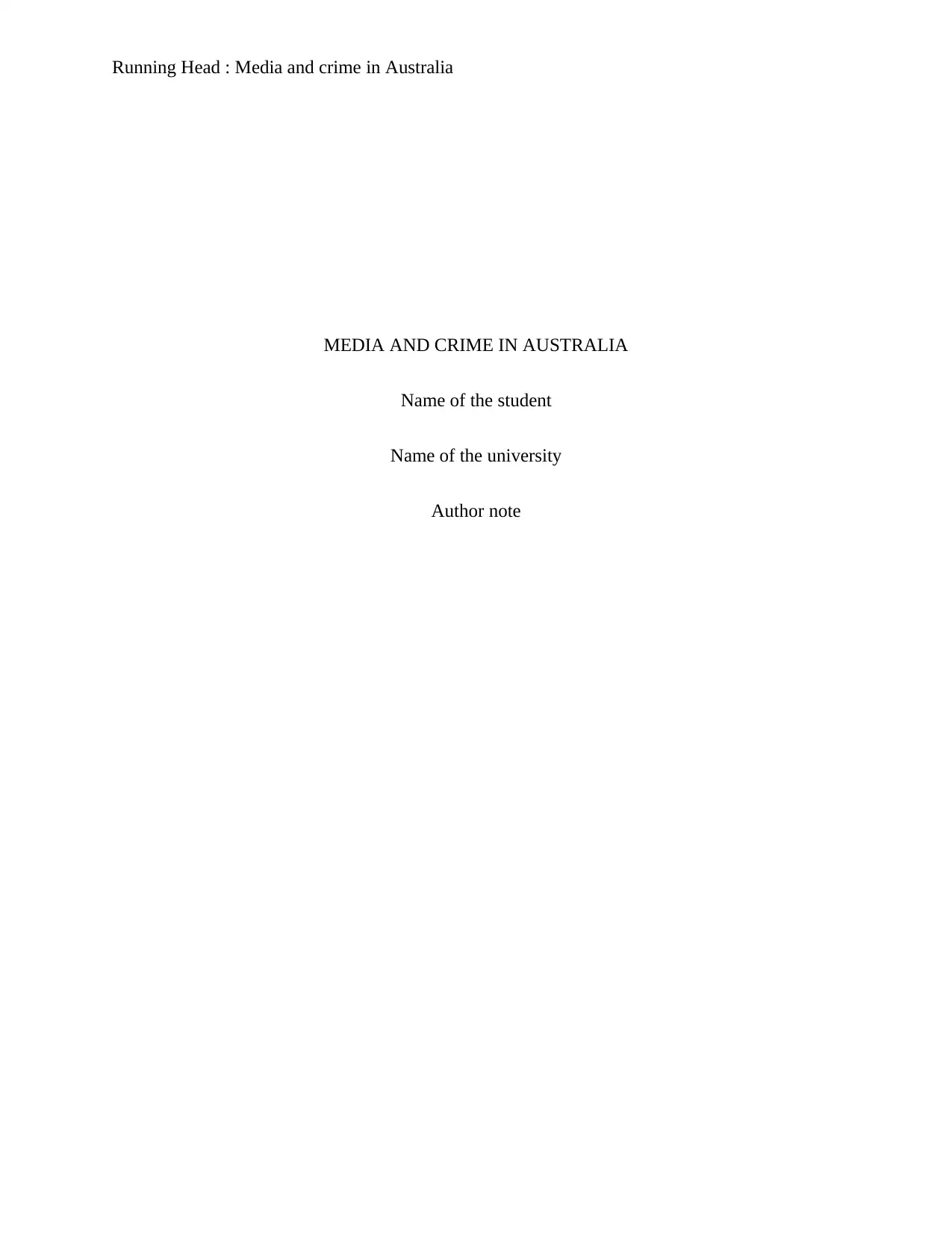
Running Head : Media and crime in Australia
MEDIA AND CRIME IN AUSTRALIA
Name of the student
Name of the university
Author note
MEDIA AND CRIME IN AUSTRALIA
Name of the student
Name of the university
Author note
Secure Best Marks with AI Grader
Need help grading? Try our AI Grader for instant feedback on your assignments.
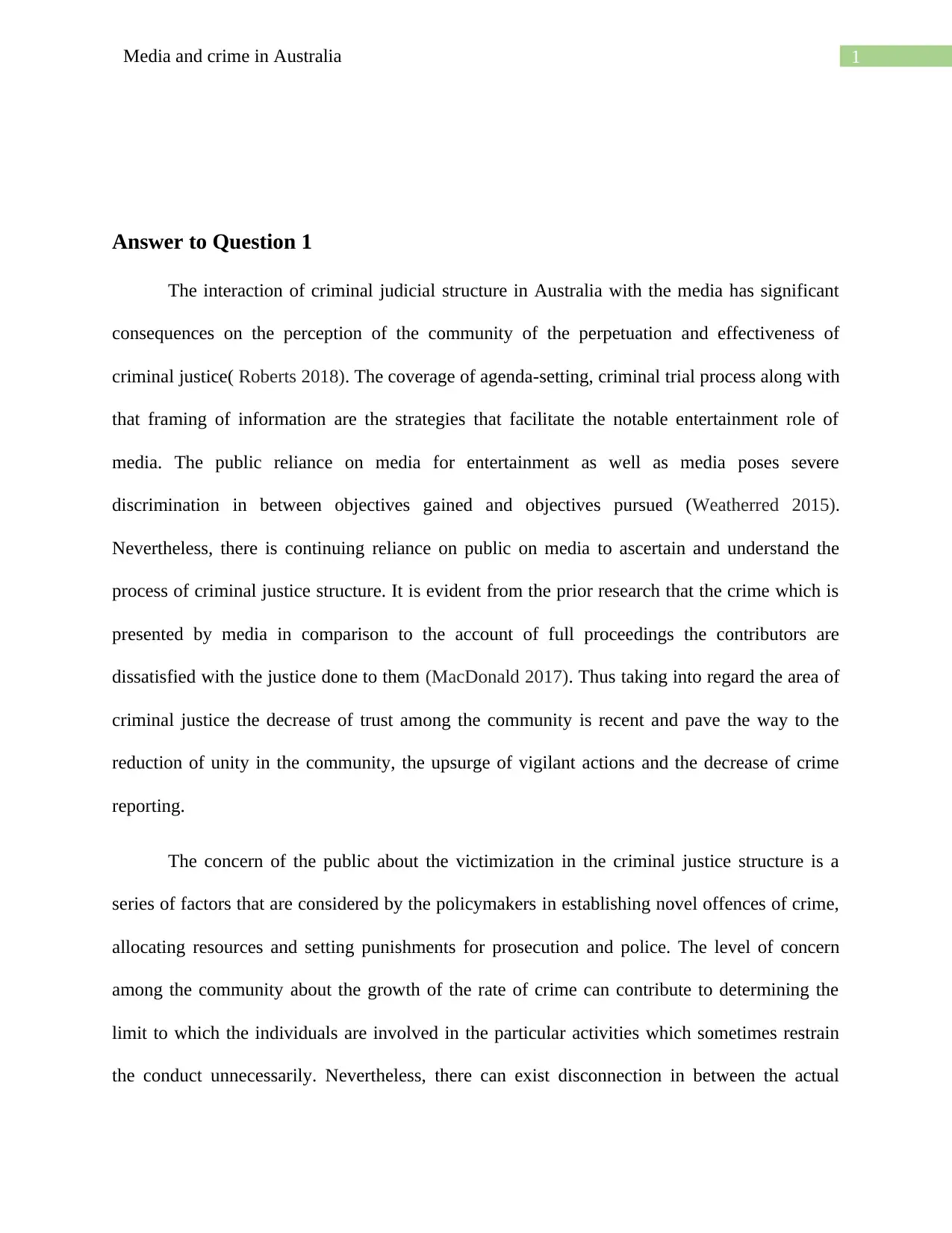
1Media and crime in Australia
Answer to Question 1
The interaction of criminal judicial structure in Australia with the media has significant
consequences on the perception of the community of the perpetuation and effectiveness of
criminal justice( Roberts 2018). The coverage of agenda-setting, criminal trial process along with
that framing of information are the strategies that facilitate the notable entertainment role of
media. The public reliance on media for entertainment as well as media poses severe
discrimination in between objectives gained and objectives pursued (Weatherred 2015).
Nevertheless, there is continuing reliance on public on media to ascertain and understand the
process of criminal justice structure. It is evident from the prior research that the crime which is
presented by media in comparison to the account of full proceedings the contributors are
dissatisfied with the justice done to them (MacDonald 2017). Thus taking into regard the area of
criminal justice the decrease of trust among the community is recent and pave the way to the
reduction of unity in the community, the upsurge of vigilant actions and the decrease of crime
reporting.
The concern of the public about the victimization in the criminal justice structure is a
series of factors that are considered by the policymakers in establishing novel offences of crime,
allocating resources and setting punishments for prosecution and police. The level of concern
among the community about the growth of the rate of crime can contribute to determining the
limit to which the individuals are involved in the particular activities which sometimes restrain
the conduct unnecessarily. Nevertheless, there can exist disconnection in between the actual
Answer to Question 1
The interaction of criminal judicial structure in Australia with the media has significant
consequences on the perception of the community of the perpetuation and effectiveness of
criminal justice( Roberts 2018). The coverage of agenda-setting, criminal trial process along with
that framing of information are the strategies that facilitate the notable entertainment role of
media. The public reliance on media for entertainment as well as media poses severe
discrimination in between objectives gained and objectives pursued (Weatherred 2015).
Nevertheless, there is continuing reliance on public on media to ascertain and understand the
process of criminal justice structure. It is evident from the prior research that the crime which is
presented by media in comparison to the account of full proceedings the contributors are
dissatisfied with the justice done to them (MacDonald 2017). Thus taking into regard the area of
criminal justice the decrease of trust among the community is recent and pave the way to the
reduction of unity in the community, the upsurge of vigilant actions and the decrease of crime
reporting.
The concern of the public about the victimization in the criminal justice structure is a
series of factors that are considered by the policymakers in establishing novel offences of crime,
allocating resources and setting punishments for prosecution and police. The level of concern
among the community about the growth of the rate of crime can contribute to determining the
limit to which the individuals are involved in the particular activities which sometimes restrain
the conduct unnecessarily. Nevertheless, there can exist disconnection in between the actual
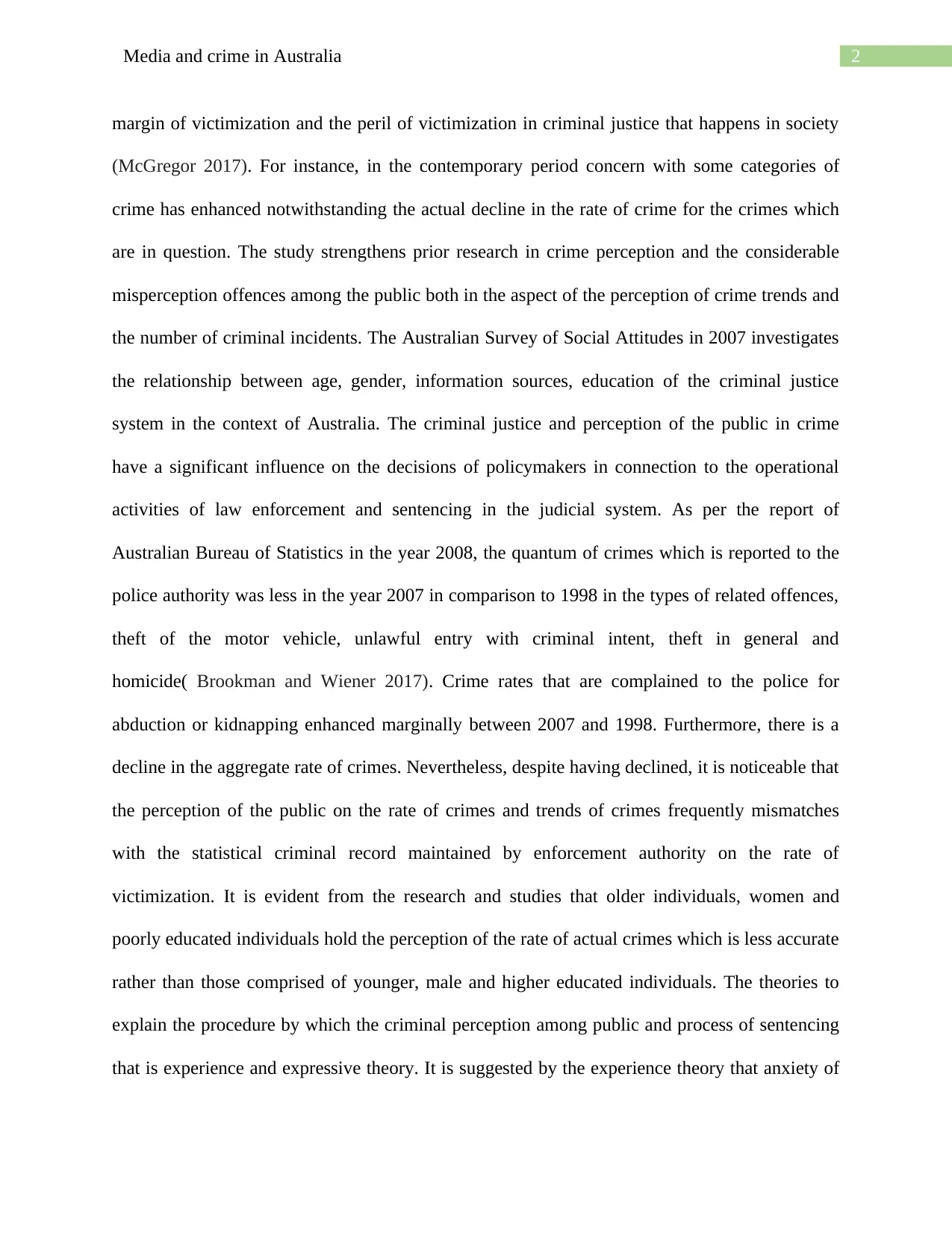
2Media and crime in Australia
margin of victimization and the peril of victimization in criminal justice that happens in society
(McGregor 2017). For instance, in the contemporary period concern with some categories of
crime has enhanced notwithstanding the actual decline in the rate of crime for the crimes which
are in question. The study strengthens prior research in crime perception and the considerable
misperception offences among the public both in the aspect of the perception of crime trends and
the number of criminal incidents. The Australian Survey of Social Attitudes in 2007 investigates
the relationship between age, gender, information sources, education of the criminal justice
system in the context of Australia. The criminal justice and perception of the public in crime
have a significant influence on the decisions of policymakers in connection to the operational
activities of law enforcement and sentencing in the judicial system. As per the report of
Australian Bureau of Statistics in the year 2008, the quantum of crimes which is reported to the
police authority was less in the year 2007 in comparison to 1998 in the types of related offences,
theft of the motor vehicle, unlawful entry with criminal intent, theft in general and
homicide( Brookman and Wiener 2017). Crime rates that are complained to the police for
abduction or kidnapping enhanced marginally between 2007 and 1998. Furthermore, there is a
decline in the aggregate rate of crimes. Nevertheless, despite having declined, it is noticeable that
the perception of the public on the rate of crimes and trends of crimes frequently mismatches
with the statistical criminal record maintained by enforcement authority on the rate of
victimization. It is evident from the research and studies that older individuals, women and
poorly educated individuals hold the perception of the rate of actual crimes which is less accurate
rather than those comprised of younger, male and higher educated individuals. The theories to
explain the procedure by which the criminal perception among public and process of sentencing
that is experience and expressive theory. It is suggested by the experience theory that anxiety of
margin of victimization and the peril of victimization in criminal justice that happens in society
(McGregor 2017). For instance, in the contemporary period concern with some categories of
crime has enhanced notwithstanding the actual decline in the rate of crime for the crimes which
are in question. The study strengthens prior research in crime perception and the considerable
misperception offences among the public both in the aspect of the perception of crime trends and
the number of criminal incidents. The Australian Survey of Social Attitudes in 2007 investigates
the relationship between age, gender, information sources, education of the criminal justice
system in the context of Australia. The criminal justice and perception of the public in crime
have a significant influence on the decisions of policymakers in connection to the operational
activities of law enforcement and sentencing in the judicial system. As per the report of
Australian Bureau of Statistics in the year 2008, the quantum of crimes which is reported to the
police authority was less in the year 2007 in comparison to 1998 in the types of related offences,
theft of the motor vehicle, unlawful entry with criminal intent, theft in general and
homicide( Brookman and Wiener 2017). Crime rates that are complained to the police for
abduction or kidnapping enhanced marginally between 2007 and 1998. Furthermore, there is a
decline in the aggregate rate of crimes. Nevertheless, despite having declined, it is noticeable that
the perception of the public on the rate of crimes and trends of crimes frequently mismatches
with the statistical criminal record maintained by enforcement authority on the rate of
victimization. It is evident from the research and studies that older individuals, women and
poorly educated individuals hold the perception of the rate of actual crimes which is less accurate
rather than those comprised of younger, male and higher educated individuals. The theories to
explain the procedure by which the criminal perception among public and process of sentencing
that is experience and expressive theory. It is suggested by the experience theory that anxiety of
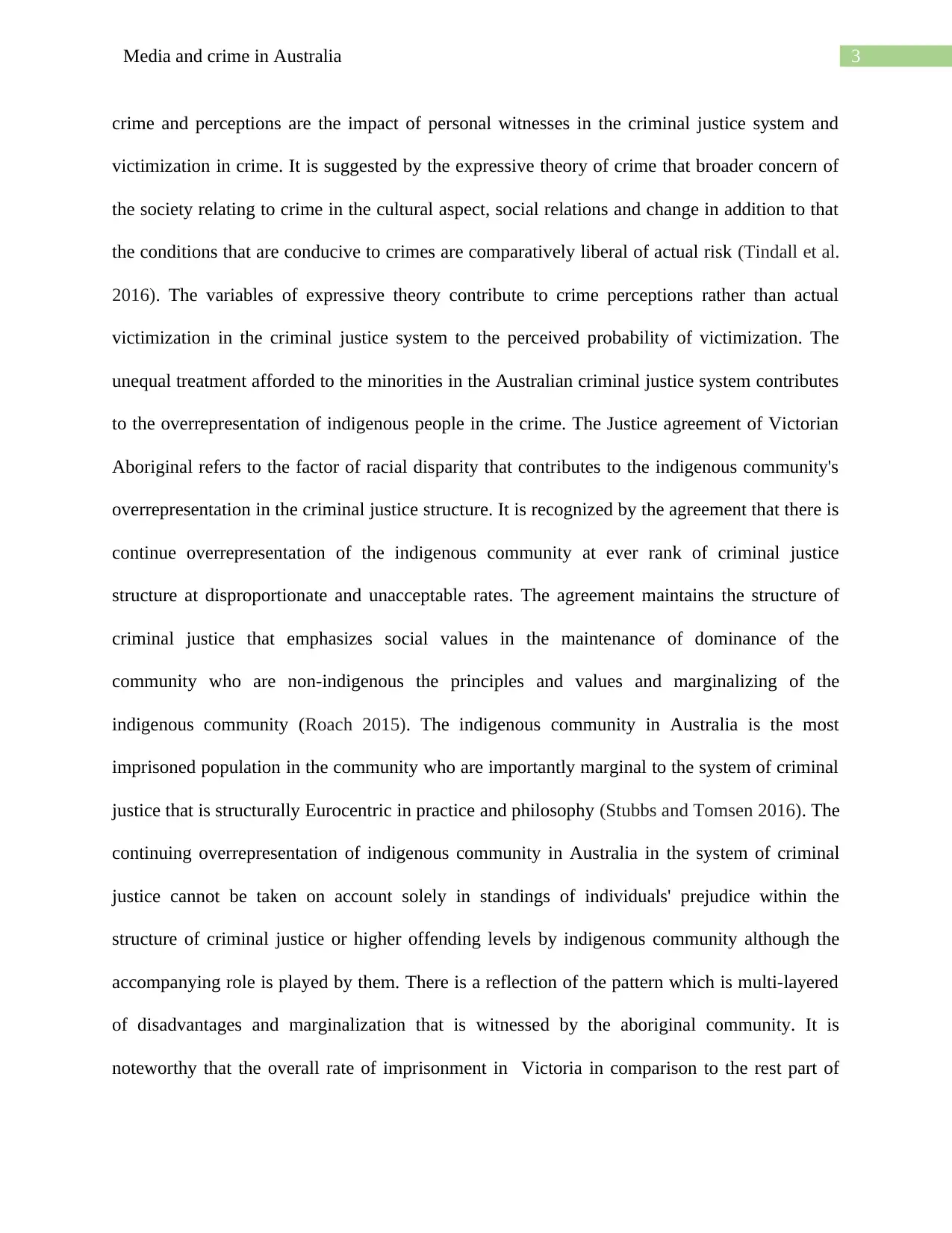
3Media and crime in Australia
crime and perceptions are the impact of personal witnesses in the criminal justice system and
victimization in crime. It is suggested by the expressive theory of crime that broader concern of
the society relating to crime in the cultural aspect, social relations and change in addition to that
the conditions that are conducive to crimes are comparatively liberal of actual risk (Tindall et al.
2016). The variables of expressive theory contribute to crime perceptions rather than actual
victimization in the criminal justice system to the perceived probability of victimization. The
unequal treatment afforded to the minorities in the Australian criminal justice system contributes
to the overrepresentation of indigenous people in the crime. The Justice agreement of Victorian
Aboriginal refers to the factor of racial disparity that contributes to the indigenous community's
overrepresentation in the criminal justice structure. It is recognized by the agreement that there is
continue overrepresentation of the indigenous community at ever rank of criminal justice
structure at disproportionate and unacceptable rates. The agreement maintains the structure of
criminal justice that emphasizes social values in the maintenance of dominance of the
community who are non-indigenous the principles and values and marginalizing of the
indigenous community (Roach 2015). The indigenous community in Australia is the most
imprisoned population in the community who are importantly marginal to the system of criminal
justice that is structurally Eurocentric in practice and philosophy (Stubbs and Tomsen 2016). The
continuing overrepresentation of indigenous community in Australia in the system of criminal
justice cannot be taken on account solely in standings of individuals' prejudice within the
structure of criminal justice or higher offending levels by indigenous community although the
accompanying role is played by them. There is a reflection of the pattern which is multi-layered
of disadvantages and marginalization that is witnessed by the aboriginal community. It is
noteworthy that the overall rate of imprisonment in Victoria in comparison to the rest part of
crime and perceptions are the impact of personal witnesses in the criminal justice system and
victimization in crime. It is suggested by the expressive theory of crime that broader concern of
the society relating to crime in the cultural aspect, social relations and change in addition to that
the conditions that are conducive to crimes are comparatively liberal of actual risk (Tindall et al.
2016). The variables of expressive theory contribute to crime perceptions rather than actual
victimization in the criminal justice system to the perceived probability of victimization. The
unequal treatment afforded to the minorities in the Australian criminal justice system contributes
to the overrepresentation of indigenous people in the crime. The Justice agreement of Victorian
Aboriginal refers to the factor of racial disparity that contributes to the indigenous community's
overrepresentation in the criminal justice structure. It is recognized by the agreement that there is
continue overrepresentation of the indigenous community at ever rank of criminal justice
structure at disproportionate and unacceptable rates. The agreement maintains the structure of
criminal justice that emphasizes social values in the maintenance of dominance of the
community who are non-indigenous the principles and values and marginalizing of the
indigenous community (Roach 2015). The indigenous community in Australia is the most
imprisoned population in the community who are importantly marginal to the system of criminal
justice that is structurally Eurocentric in practice and philosophy (Stubbs and Tomsen 2016). The
continuing overrepresentation of indigenous community in Australia in the system of criminal
justice cannot be taken on account solely in standings of individuals' prejudice within the
structure of criminal justice or higher offending levels by indigenous community although the
accompanying role is played by them. There is a reflection of the pattern which is multi-layered
of disadvantages and marginalization that is witnessed by the aboriginal community. It is
noteworthy that the overall rate of imprisonment in Victoria in comparison to the rest part of
Secure Best Marks with AI Grader
Need help grading? Try our AI Grader for instant feedback on your assignments.
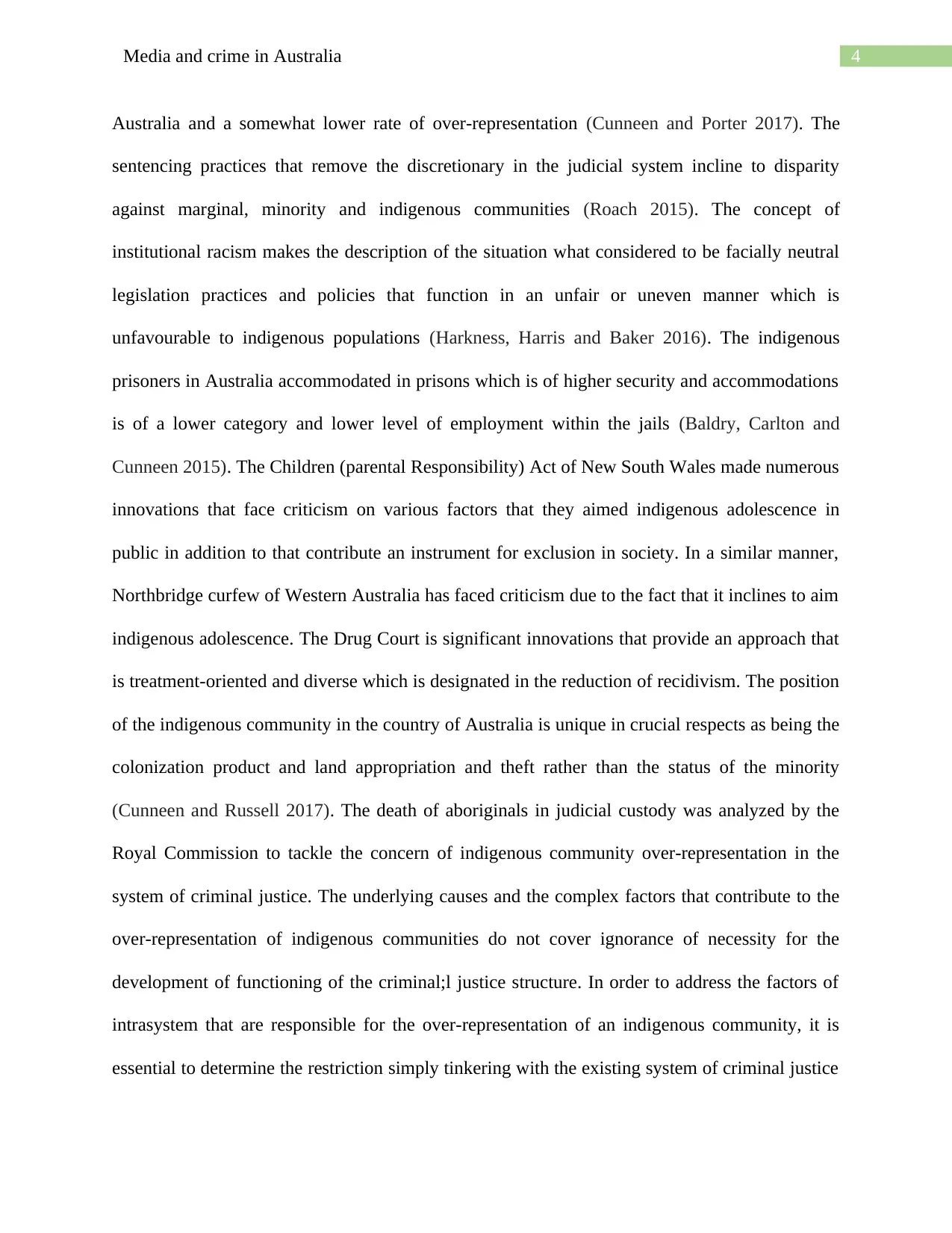
4Media and crime in Australia
Australia and a somewhat lower rate of over-representation (Cunneen and Porter 2017). The
sentencing practices that remove the discretionary in the judicial system incline to disparity
against marginal, minority and indigenous communities (Roach 2015). The concept of
institutional racism makes the description of the situation what considered to be facially neutral
legislation practices and policies that function in an unfair or uneven manner which is
unfavourable to indigenous populations (Harkness, Harris and Baker 2016). The indigenous
prisoners in Australia accommodated in prisons which is of higher security and accommodations
is of a lower category and lower level of employment within the jails (Baldry, Carlton and
Cunneen 2015). The Children (parental Responsibility) Act of New South Wales made numerous
innovations that face criticism on various factors that they aimed indigenous adolescence in
public in addition to that contribute an instrument for exclusion in society. In a similar manner,
Northbridge curfew of Western Australia has faced criticism due to the fact that it inclines to aim
indigenous adolescence. The Drug Court is significant innovations that provide an approach that
is treatment-oriented and diverse which is designated in the reduction of recidivism. The position
of the indigenous community in the country of Australia is unique in crucial respects as being the
colonization product and land appropriation and theft rather than the status of the minority
(Cunneen and Russell 2017). The death of aboriginals in judicial custody was analyzed by the
Royal Commission to tackle the concern of indigenous community over-representation in the
system of criminal justice. The underlying causes and the complex factors that contribute to the
over-representation of indigenous communities do not cover ignorance of necessity for the
development of functioning of the criminal;l justice structure. In order to address the factors of
intrasystem that are responsible for the over-representation of an indigenous community, it is
essential to determine the restriction simply tinkering with the existing system of criminal justice
Australia and a somewhat lower rate of over-representation (Cunneen and Porter 2017). The
sentencing practices that remove the discretionary in the judicial system incline to disparity
against marginal, minority and indigenous communities (Roach 2015). The concept of
institutional racism makes the description of the situation what considered to be facially neutral
legislation practices and policies that function in an unfair or uneven manner which is
unfavourable to indigenous populations (Harkness, Harris and Baker 2016). The indigenous
prisoners in Australia accommodated in prisons which is of higher security and accommodations
is of a lower category and lower level of employment within the jails (Baldry, Carlton and
Cunneen 2015). The Children (parental Responsibility) Act of New South Wales made numerous
innovations that face criticism on various factors that they aimed indigenous adolescence in
public in addition to that contribute an instrument for exclusion in society. In a similar manner,
Northbridge curfew of Western Australia has faced criticism due to the fact that it inclines to aim
indigenous adolescence. The Drug Court is significant innovations that provide an approach that
is treatment-oriented and diverse which is designated in the reduction of recidivism. The position
of the indigenous community in the country of Australia is unique in crucial respects as being the
colonization product and land appropriation and theft rather than the status of the minority
(Cunneen and Russell 2017). The death of aboriginals in judicial custody was analyzed by the
Royal Commission to tackle the concern of indigenous community over-representation in the
system of criminal justice. The underlying causes and the complex factors that contribute to the
over-representation of indigenous communities do not cover ignorance of necessity for the
development of functioning of the criminal;l justice structure. In order to address the factors of
intrasystem that are responsible for the over-representation of an indigenous community, it is
essential to determine the restriction simply tinkering with the existing system of criminal justice
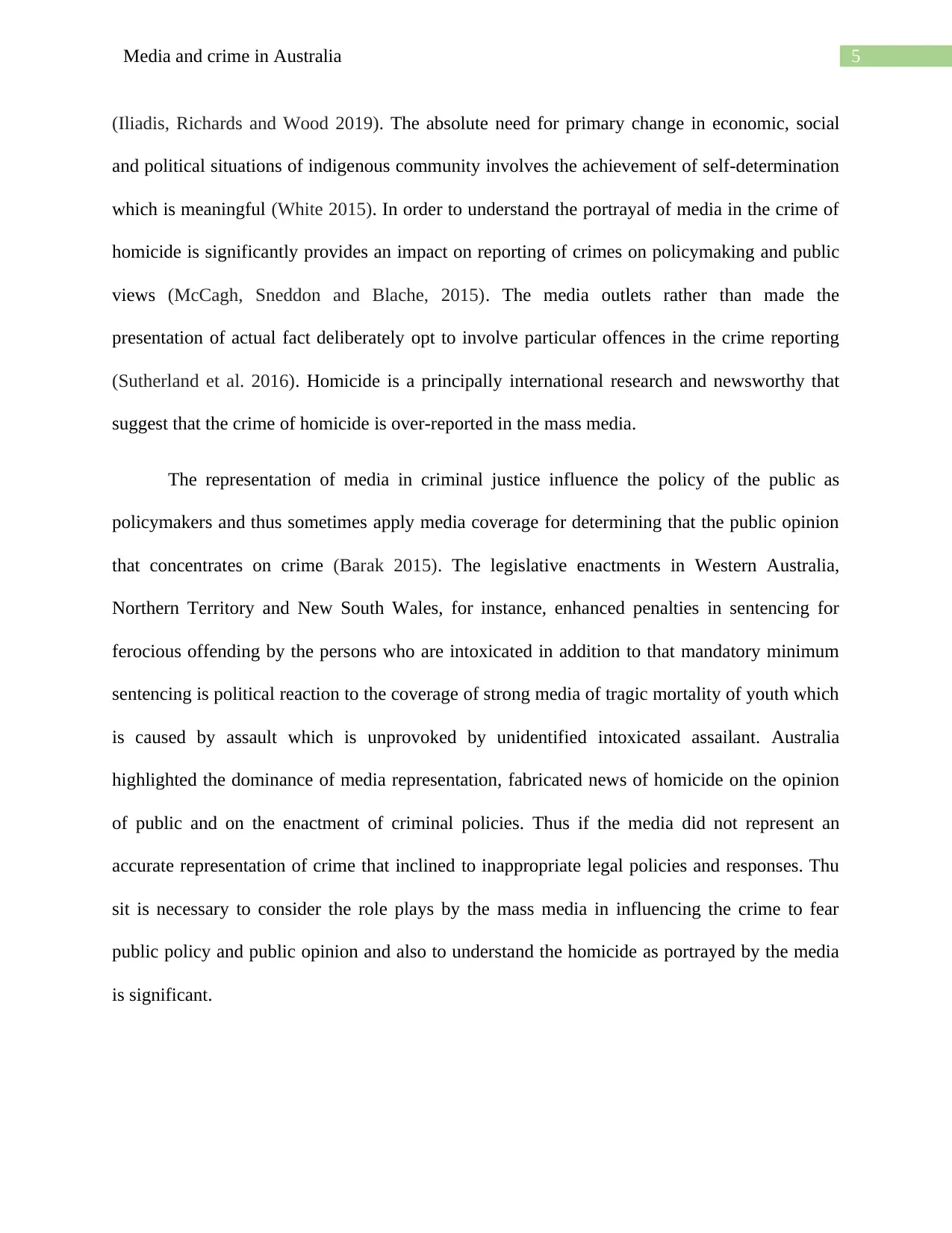
5Media and crime in Australia
(Iliadis, Richards and Wood 2019). The absolute need for primary change in economic, social
and political situations of indigenous community involves the achievement of self-determination
which is meaningful (White 2015). In order to understand the portrayal of media in the crime of
homicide is significantly provides an impact on reporting of crimes on policymaking and public
views (McCagh, Sneddon and Blache, 2015). The media outlets rather than made the
presentation of actual fact deliberately opt to involve particular offences in the crime reporting
(Sutherland et al. 2016). Homicide is a principally international research and newsworthy that
suggest that the crime of homicide is over-reported in the mass media.
The representation of media in criminal justice influence the policy of the public as
policymakers and thus sometimes apply media coverage for determining that the public opinion
that concentrates on crime (Barak 2015). The legislative enactments in Western Australia,
Northern Territory and New South Wales, for instance, enhanced penalties in sentencing for
ferocious offending by the persons who are intoxicated in addition to that mandatory minimum
sentencing is political reaction to the coverage of strong media of tragic mortality of youth which
is caused by assault which is unprovoked by unidentified intoxicated assailant. Australia
highlighted the dominance of media representation, fabricated news of homicide on the opinion
of public and on the enactment of criminal policies. Thus if the media did not represent an
accurate representation of crime that inclined to inappropriate legal policies and responses. Thu
sit is necessary to consider the role plays by the mass media in influencing the crime to fear
public policy and public opinion and also to understand the homicide as portrayed by the media
is significant.
(Iliadis, Richards and Wood 2019). The absolute need for primary change in economic, social
and political situations of indigenous community involves the achievement of self-determination
which is meaningful (White 2015). In order to understand the portrayal of media in the crime of
homicide is significantly provides an impact on reporting of crimes on policymaking and public
views (McCagh, Sneddon and Blache, 2015). The media outlets rather than made the
presentation of actual fact deliberately opt to involve particular offences in the crime reporting
(Sutherland et al. 2016). Homicide is a principally international research and newsworthy that
suggest that the crime of homicide is over-reported in the mass media.
The representation of media in criminal justice influence the policy of the public as
policymakers and thus sometimes apply media coverage for determining that the public opinion
that concentrates on crime (Barak 2015). The legislative enactments in Western Australia,
Northern Territory and New South Wales, for instance, enhanced penalties in sentencing for
ferocious offending by the persons who are intoxicated in addition to that mandatory minimum
sentencing is political reaction to the coverage of strong media of tragic mortality of youth which
is caused by assault which is unprovoked by unidentified intoxicated assailant. Australia
highlighted the dominance of media representation, fabricated news of homicide on the opinion
of public and on the enactment of criminal policies. Thus if the media did not represent an
accurate representation of crime that inclined to inappropriate legal policies and responses. Thu
sit is necessary to consider the role plays by the mass media in influencing the crime to fear
public policy and public opinion and also to understand the homicide as portrayed by the media
is significant.
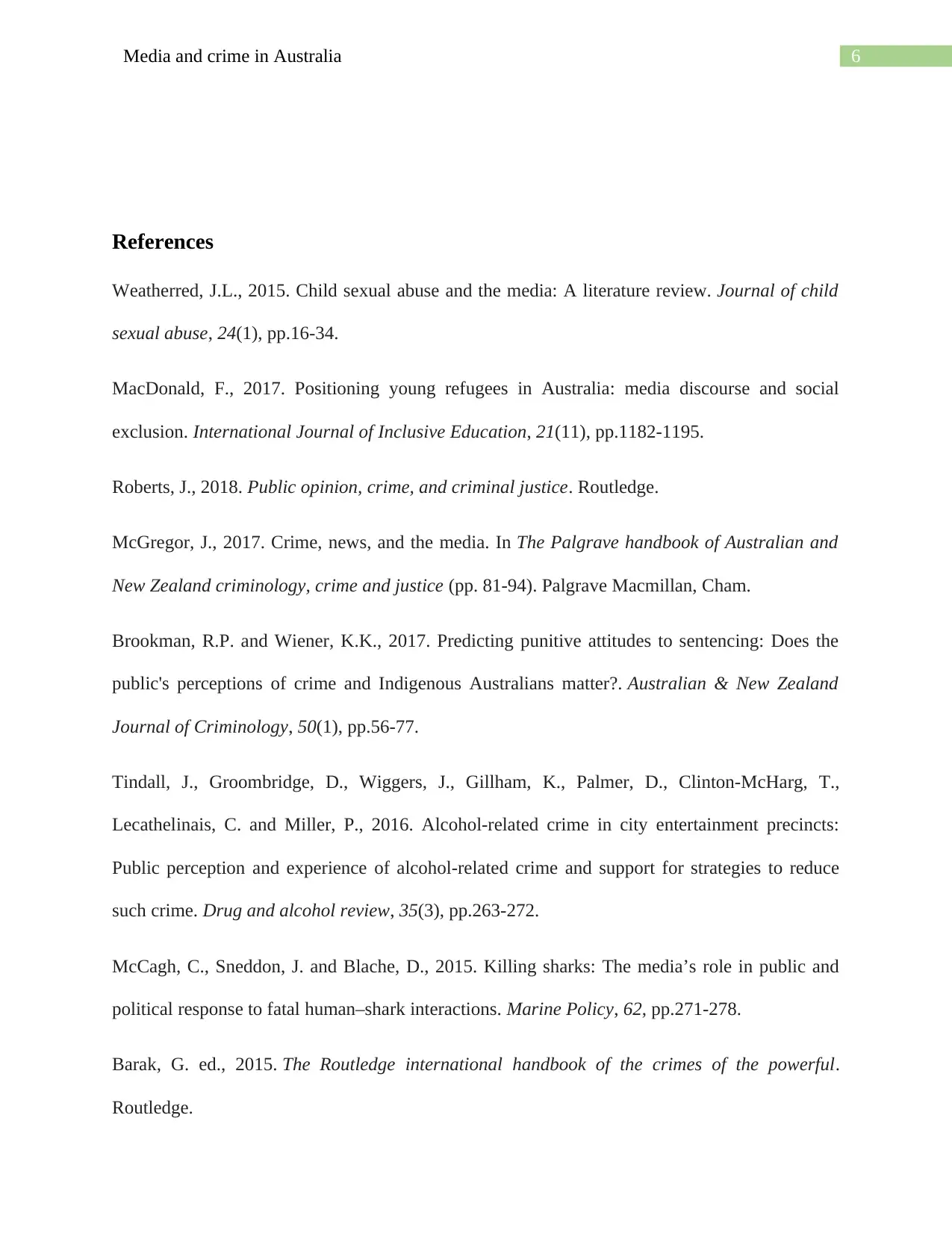
6Media and crime in Australia
References
Weatherred, J.L., 2015. Child sexual abuse and the media: A literature review. Journal of child
sexual abuse, 24(1), pp.16-34.
MacDonald, F., 2017. Positioning young refugees in Australia: media discourse and social
exclusion. International Journal of Inclusive Education, 21(11), pp.1182-1195.
Roberts, J., 2018. Public opinion, crime, and criminal justice. Routledge.
McGregor, J., 2017. Crime, news, and the media. In The Palgrave handbook of Australian and
New Zealand criminology, crime and justice (pp. 81-94). Palgrave Macmillan, Cham.
Brookman, R.P. and Wiener, K.K., 2017. Predicting punitive attitudes to sentencing: Does the
public's perceptions of crime and Indigenous Australians matter?. Australian & New Zealand
Journal of Criminology, 50(1), pp.56-77.
Tindall, J., Groombridge, D., Wiggers, J., Gillham, K., Palmer, D., Clinton‐McHarg, T.,
Lecathelinais, C. and Miller, P., 2016. Alcohol‐related crime in city entertainment precincts:
Public perception and experience of alcohol‐related crime and support for strategies to reduce
such crime. Drug and alcohol review, 35(3), pp.263-272.
McCagh, C., Sneddon, J. and Blache, D., 2015. Killing sharks: The media’s role in public and
political response to fatal human–shark interactions. Marine Policy, 62, pp.271-278.
Barak, G. ed., 2015. The Routledge international handbook of the crimes of the powerful.
Routledge.
References
Weatherred, J.L., 2015. Child sexual abuse and the media: A literature review. Journal of child
sexual abuse, 24(1), pp.16-34.
MacDonald, F., 2017. Positioning young refugees in Australia: media discourse and social
exclusion. International Journal of Inclusive Education, 21(11), pp.1182-1195.
Roberts, J., 2018. Public opinion, crime, and criminal justice. Routledge.
McGregor, J., 2017. Crime, news, and the media. In The Palgrave handbook of Australian and
New Zealand criminology, crime and justice (pp. 81-94). Palgrave Macmillan, Cham.
Brookman, R.P. and Wiener, K.K., 2017. Predicting punitive attitudes to sentencing: Does the
public's perceptions of crime and Indigenous Australians matter?. Australian & New Zealand
Journal of Criminology, 50(1), pp.56-77.
Tindall, J., Groombridge, D., Wiggers, J., Gillham, K., Palmer, D., Clinton‐McHarg, T.,
Lecathelinais, C. and Miller, P., 2016. Alcohol‐related crime in city entertainment precincts:
Public perception and experience of alcohol‐related crime and support for strategies to reduce
such crime. Drug and alcohol review, 35(3), pp.263-272.
McCagh, C., Sneddon, J. and Blache, D., 2015. Killing sharks: The media’s role in public and
political response to fatal human–shark interactions. Marine Policy, 62, pp.271-278.
Barak, G. ed., 2015. The Routledge international handbook of the crimes of the powerful.
Routledge.
Paraphrase This Document
Need a fresh take? Get an instant paraphrase of this document with our AI Paraphraser
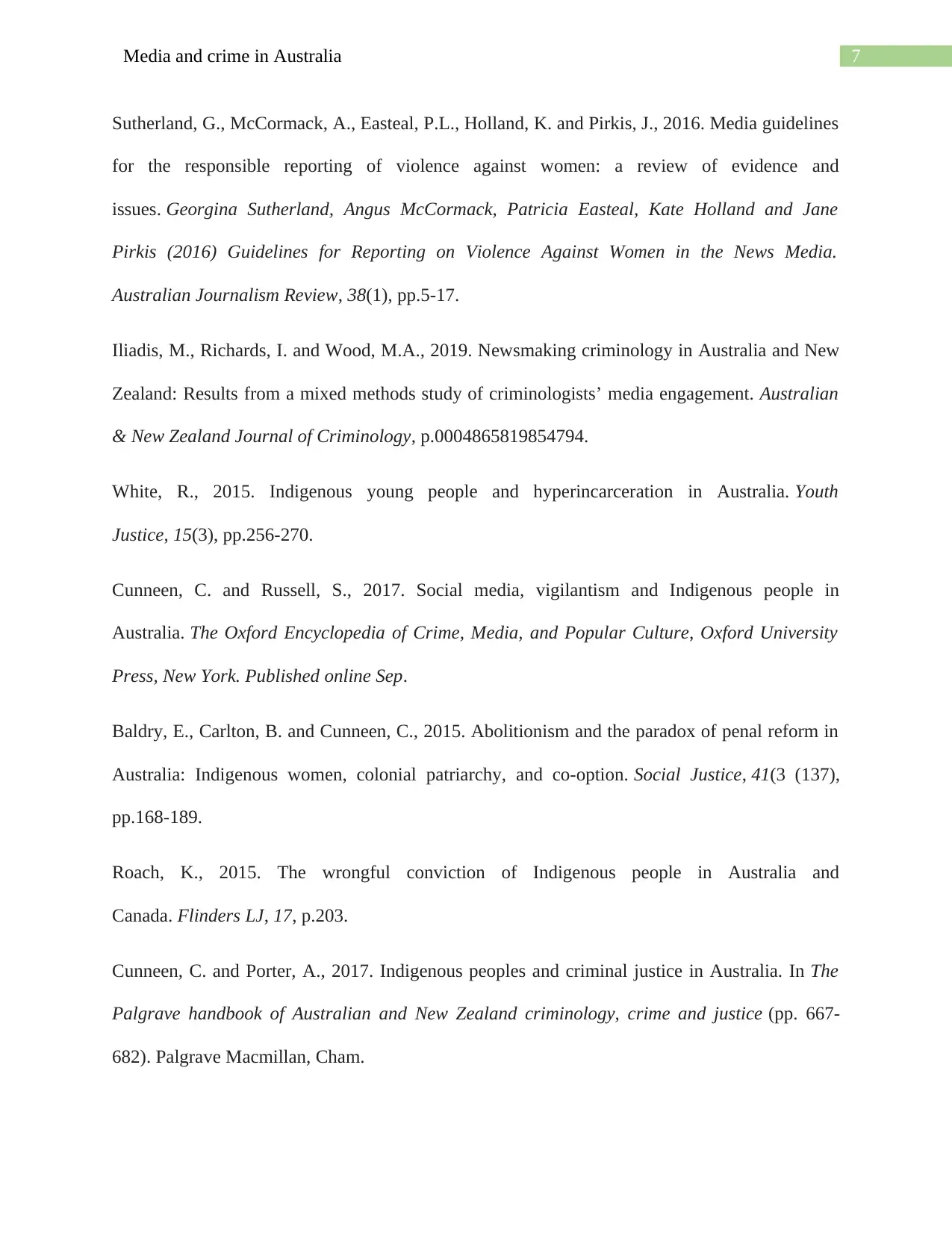
7Media and crime in Australia
Sutherland, G., McCormack, A., Easteal, P.L., Holland, K. and Pirkis, J., 2016. Media guidelines
for the responsible reporting of violence against women: a review of evidence and
issues. Georgina Sutherland, Angus McCormack, Patricia Easteal, Kate Holland and Jane
Pirkis (2016) Guidelines for Reporting on Violence Against Women in the News Media.
Australian Journalism Review, 38(1), pp.5-17.
Iliadis, M., Richards, I. and Wood, M.A., 2019. Newsmaking criminology in Australia and New
Zealand: Results from a mixed methods study of criminologists’ media engagement. Australian
& New Zealand Journal of Criminology, p.0004865819854794.
White, R., 2015. Indigenous young people and hyperincarceration in Australia. Youth
Justice, 15(3), pp.256-270.
Cunneen, C. and Russell, S., 2017. Social media, vigilantism and Indigenous people in
Australia. The Oxford Encyclopedia of Crime, Media, and Popular Culture, Oxford University
Press, New York. Published online Sep.
Baldry, E., Carlton, B. and Cunneen, C., 2015. Abolitionism and the paradox of penal reform in
Australia: Indigenous women, colonial patriarchy, and co-option. Social Justice, 41(3 (137),
pp.168-189.
Roach, K., 2015. The wrongful conviction of Indigenous people in Australia and
Canada. Flinders LJ, 17, p.203.
Cunneen, C. and Porter, A., 2017. Indigenous peoples and criminal justice in Australia. In The
Palgrave handbook of Australian and New Zealand criminology, crime and justice (pp. 667-
682). Palgrave Macmillan, Cham.
Sutherland, G., McCormack, A., Easteal, P.L., Holland, K. and Pirkis, J., 2016. Media guidelines
for the responsible reporting of violence against women: a review of evidence and
issues. Georgina Sutherland, Angus McCormack, Patricia Easteal, Kate Holland and Jane
Pirkis (2016) Guidelines for Reporting on Violence Against Women in the News Media.
Australian Journalism Review, 38(1), pp.5-17.
Iliadis, M., Richards, I. and Wood, M.A., 2019. Newsmaking criminology in Australia and New
Zealand: Results from a mixed methods study of criminologists’ media engagement. Australian
& New Zealand Journal of Criminology, p.0004865819854794.
White, R., 2015. Indigenous young people and hyperincarceration in Australia. Youth
Justice, 15(3), pp.256-270.
Cunneen, C. and Russell, S., 2017. Social media, vigilantism and Indigenous people in
Australia. The Oxford Encyclopedia of Crime, Media, and Popular Culture, Oxford University
Press, New York. Published online Sep.
Baldry, E., Carlton, B. and Cunneen, C., 2015. Abolitionism and the paradox of penal reform in
Australia: Indigenous women, colonial patriarchy, and co-option. Social Justice, 41(3 (137),
pp.168-189.
Roach, K., 2015. The wrongful conviction of Indigenous people in Australia and
Canada. Flinders LJ, 17, p.203.
Cunneen, C. and Porter, A., 2017. Indigenous peoples and criminal justice in Australia. In The
Palgrave handbook of Australian and New Zealand criminology, crime and justice (pp. 667-
682). Palgrave Macmillan, Cham.
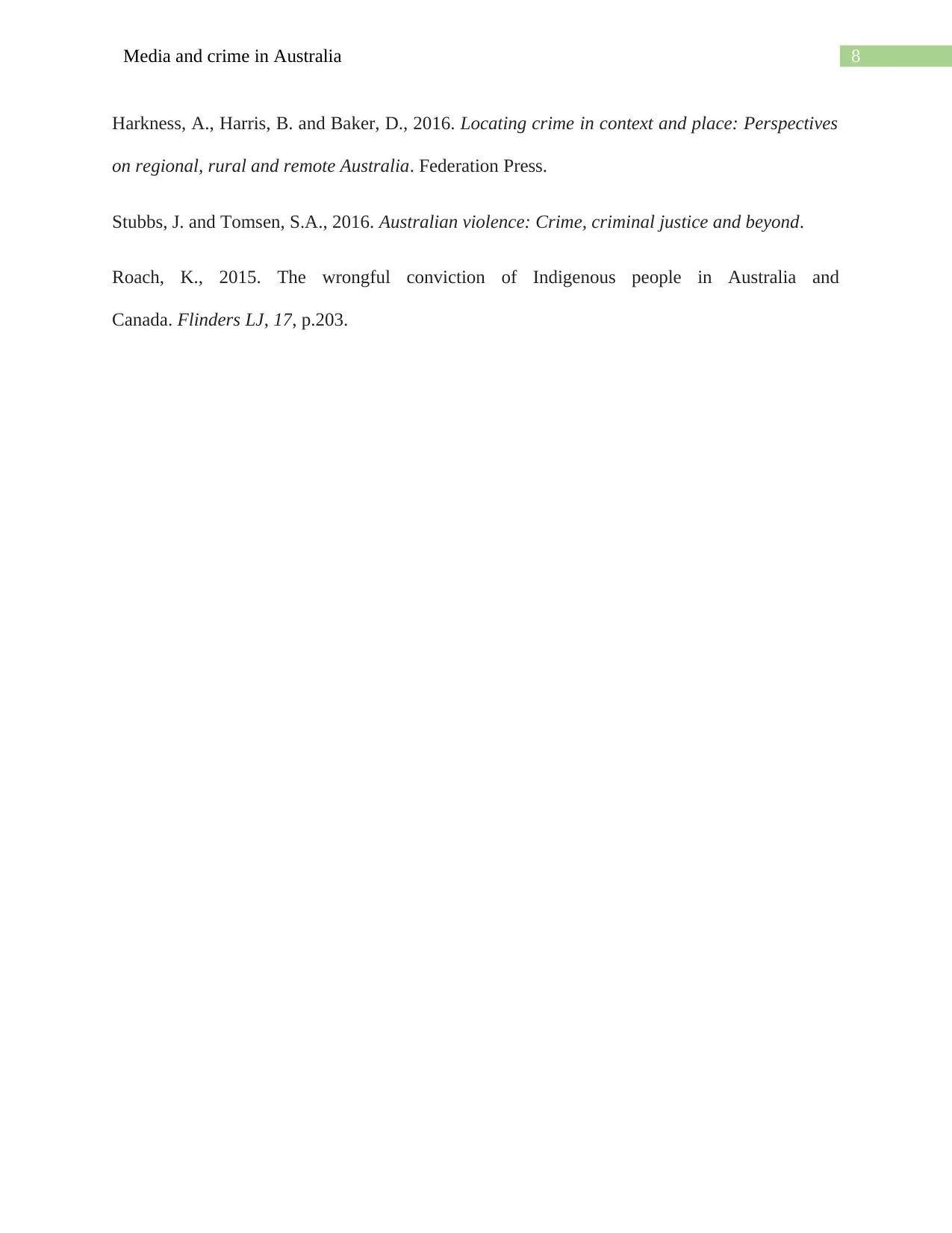
8Media and crime in Australia
Harkness, A., Harris, B. and Baker, D., 2016. Locating crime in context and place: Perspectives
on regional, rural and remote Australia. Federation Press.
Stubbs, J. and Tomsen, S.A., 2016. Australian violence: Crime, criminal justice and beyond.
Roach, K., 2015. The wrongful conviction of Indigenous people in Australia and
Canada. Flinders LJ, 17, p.203.
Harkness, A., Harris, B. and Baker, D., 2016. Locating crime in context and place: Perspectives
on regional, rural and remote Australia. Federation Press.
Stubbs, J. and Tomsen, S.A., 2016. Australian violence: Crime, criminal justice and beyond.
Roach, K., 2015. The wrongful conviction of Indigenous people in Australia and
Canada. Flinders LJ, 17, p.203.
1 out of 9
Related Documents
Your All-in-One AI-Powered Toolkit for Academic Success.
+13062052269
info@desklib.com
Available 24*7 on WhatsApp / Email
![[object Object]](/_next/static/media/star-bottom.7253800d.svg)
Unlock your academic potential
© 2024 | Zucol Services PVT LTD | All rights reserved.





